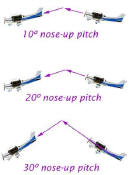Stall Perspective
Some pilots are not comfortable with slow flight and stalls. Often this is due to a lack of understanding as a result of their initial pilot training. When a flight school fails to provide a complete explanation of stalls, resorting to an oversimplified presentation that leads to misconceptions, the student is not at ease during the performance of practice stalls.
The typical general aviation pilot has been told that Bernoulli's Principle creates the lift of a wing, by producing a pressure differential between the top and bottom surface of the wing.
Newton's Third Law of Motion—every action has an equal and opposite reaction—means the wing pushes down on the air and the opposing force is for the air to push up on the wing.
Enough about aerodynamics. What I want to do is present a different perspective concerning stall recovery. With an airplane trimmed for straight-and-level flight, we can perform power-off and power-on stalls and develop an understanding about what the airplane wants to do.
The airplane, when stalled, will form an isosceles triangle. For example:
In the first example, the power is reduced. The nose is slowly raised until encountering the stall. If the control wheel (stick) is released at the moment of the stall, the nose will lower an amount equal to the nose-up attitude when the aircraft stalled. The same is true of any other nose-up attitude, whether the power is on or off. The airplane forms an isosceles triangle during its self recovery.
To expedite the recovery with a lesser amount of altitude loss and to prevent an oscillation, the pilot can effect the recovery. Knowing the airplane stalls at a given angle of attack, say 18 degrees, it is merely necessary to make the recovery based upon the attitude when the airplane stalled. For example, if the attitude was 20-degrees nose-up when the stall occurs, lowering the nose 5 degrees will result in the minimum loss of altitude (this results in a 15-degree angle of attack). If the attitude was 40-degrees nose-up at the moment of the stall, lower the nose 40 degrees, less the 15-degree angle at which the airplane will fly, for an effective recovery. This occurs when the nose is 25 degrees below the horizon.


